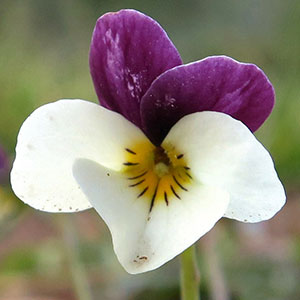Viola hallii
Viola pedata
Hall's violet, Oregon violet, wild pansy
bird-foot violet
1–3, decumbent or ascending to erect, ca. 1/2 subterranean, glabrous, clustered on single, short, vertical, deep-seated caudex.
basal and cauline;
basal: 1–4, palmately compound, ± 2-ternate or 3-ternate, leaflets 3;
stipules adnate to petiole, forming 2 linear-lanceolate wings, unlobed, margins entire, apex of each wing free, acute;
petiole 5–8 cm, glabrous;
blade ovate to deltate, 2.8–6 × 2.6–6.5 cm, ± coriaceous, base tapered, ultimate lobes narrowly elliptic, lanceolate, or oblanceolate, 1–7 mm wide, margins entire, ciliate or eciliate, apex acute, mucronulate, surfaces glabrous;
cauline similar to basal except: stipules usually lanceolate, sometimes broadly ovate, ± leaflike, margins toothed;
petiole 1.3–6 cm;
blade 2–4.8 × 1.2–5.5 cm.
basal, 4–10, ascending to erect, deeply divided;
stipules linear-lanceolate, margins entire, lacerate, or shallowly divided, apex acute;
petiole 2–12 cm, glabrous or sparsely puberulent;
blade 3–9(–10)-lobed, lobes similar in width and shape, spatulate, lanceolate ± linear, deltate, or ovate, 1–4 × 1–4 cm, base attenuate or broadly cordate to cuneate, margins entire, ciliate or eciliate, apex rounded to usually acute, surfaces usually glabrous, sometimes pubescent on abaxial veins.
2.5–11 cm, glabrous.
5–12 cm, glabrous or pubescent.
sepals lanceolate to ovate, margins ciliate, auricles 0.5–1 mm;
petals: upper 2 almost black abaxially, dark reddish violet adaxially, lower 3 pale yellow, cream, or ± white, lateral 2 bearded, with deep yellow to orange patch basally, dark reddish violet-veined, lowest with deep yellow to orange patch basally, dark reddish violet-veined, 5–18 mm, spur yellow, gibbous, 0.5–2 mm;
style head bearded; cleistogamous flowers absent.
sepals lanceolate, margins mostly ciliate, at least proximally, auricles 1–2 mm;
petals uniformly light to dark blue-violet on both surfaces or upper 2 darker adaxially, sometimes white, upper and lateral 2 often darker basally, lowest, seldom others, dark violet-veined, all beardless, lowest white basally, 12–24 mm, spur white, gibbous, 2–3 mm;
style head beardless; cleistogamous flowers absent.
ellipsoid, 4–12 mm, glabrous.
ellipsoid, 6–10 mm, glabrous.
light brown, shiny, 3.2–3.5 mm.
beige, mottled to brown, 1.4–3 mm.
= 60, 72.
= 56.
Viola hallii
Viola pedata
Viola hallii was discovered on the grounds of Willamette University in Salem, Oregon, by Elihu Hall, a professor at that institution (V. B. Baird 1942). Leaves of V. hallii are similar to V. beckwithii.
(Discussion copyrighted by Flora of North America; reprinted with permission.)
Varieties 2 (2 in the flora).
(Discussion copyrighted by Flora of North America; reprinted with permission.)
1. Leaf blades 7–9-lobed, lobes spatulate, lanceolate, or ± linear, sometimes with narrowly deltate to falcate appendages toward apex. | var. pedata |
1. Leaf blades 3–5(–10)-lobed, lobes deltate or ovate. | var. ranunculifolia |


